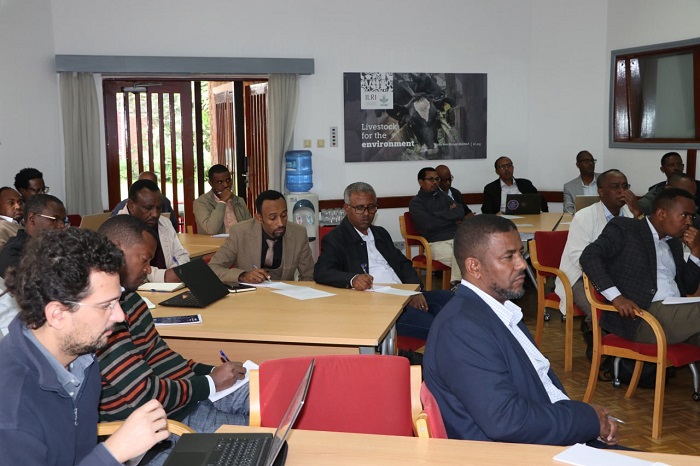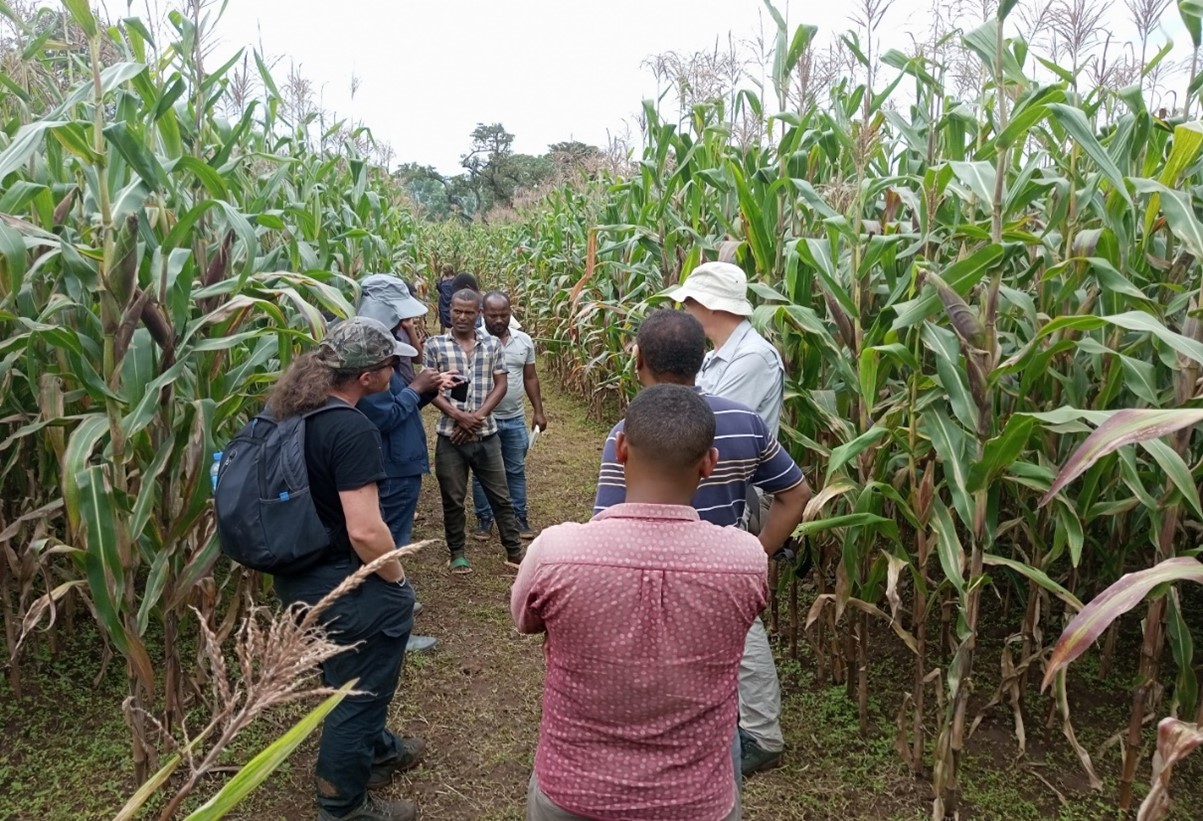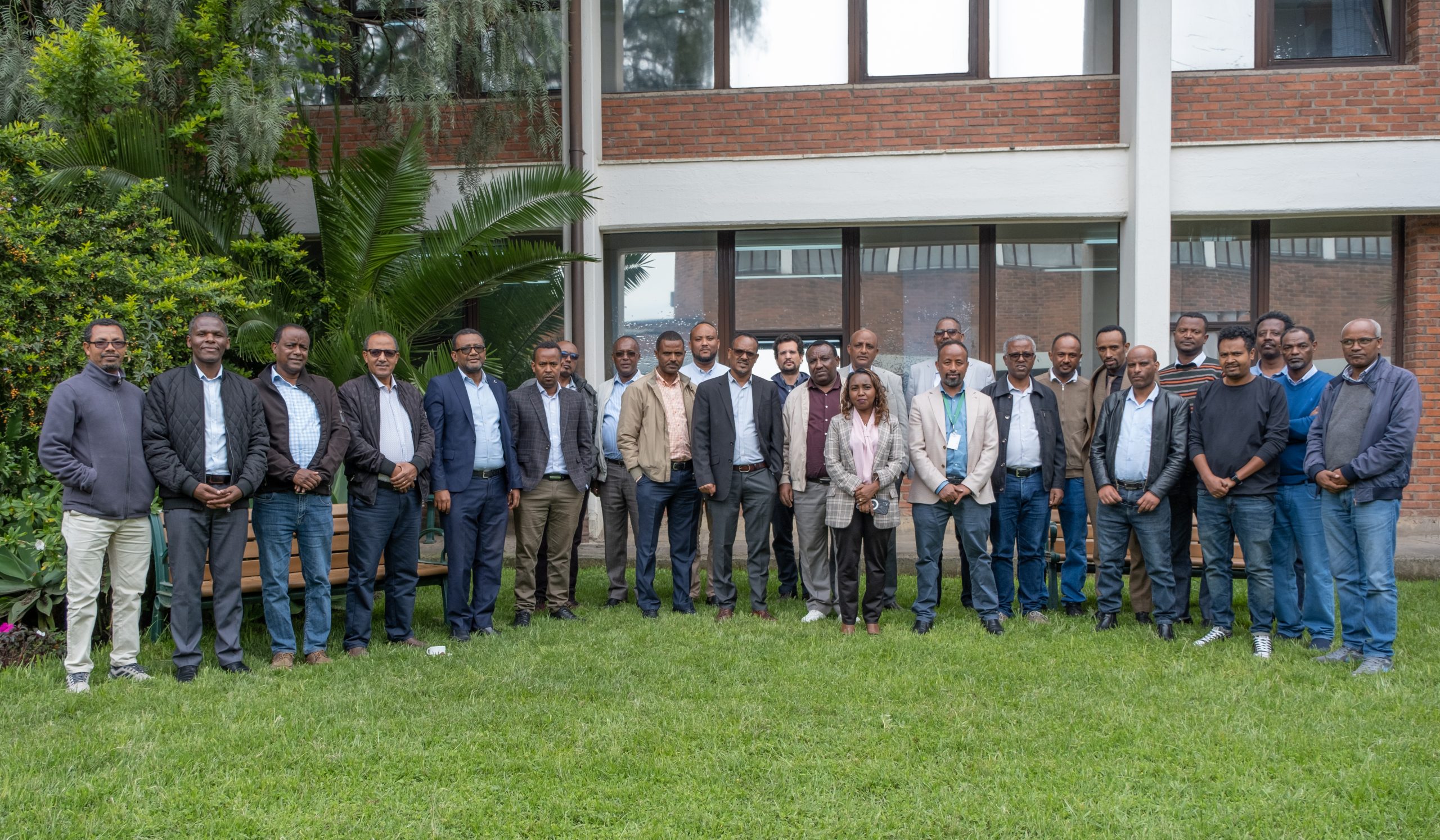October 25, 2024
By Desalegne Tadesse
Methods developed under CIMMYT’s GAIA project and adopted by national partners recognized as a success for acid soil remediation in Ethiopia
Ethiopia’s agricultural and food production systems face significant challenges due to soil acidity. Approximately 41% of the country’s cultivated land is affected, with 28% of this area being highly acidic. Heavy rainfall and inherent soil properties are significant drivers of this, and practices like continuous residue removal greatly accelerate these conditions.
 Stakeholders attending the national workshop on acid soil management in Addis Ababa, Ethiopia (Photo: CIMMYT)
Stakeholders attending the national workshop on acid soil management in Addis Ababa, Ethiopia (Photo: CIMMYT)
The resulting acidic soil conditions can severely limit the uptake of critical nutrients, leading to lower yields and poorer crop responses to inputs. As a result, Ethiopia’s soil acidity conditions constrain the production and productivity of the country’s main staple crops and compromise efforts to achieve national food security. To help address these problems, policymakers, technical experts, and development partners in Ethiopia have come together to advocate for innovative data-driven solutions to remediate acid soils to raise crop yields and promote sustainable economic growth.
“At a national workshop convened by CIMMYT and the One CGIAR initiative on Excellence in Agronomy on 29 July 2024 in Addis Ababa, experts from CGIAR, the Ministry of Agriculture (MoA), the Ethiopian Institute of Agricultural Research (EIAR), universities, regional research institutes, the national soil health task force, NGOs, and other key stakeholders gathered to discuss acid soil management in Ethiopia. Participants emphasized that proper management of soil acidity could increase fertilizer use efficiency from 20% to as much as 90%, depending on the initial acidity levels and specific nutrients involved.
Tackling soil acidity
“Acidic soils are complex and widespread, affecting millions of hectares of arable land in Ethiopia,” said Tesfaye Shiferaw, an agronomist with CIMMYT’s Sustainable Agrifood Systems program and regional lead for the One CGIAR initiative on Excellence in Agronomy. “We understand the situation well and have developed innovative solutions under the GAIA project to address the issue. The spatial targeting framework created within the project represents a significant breakthrough, which the MoA has incorporated into Ethiopia’s nationwide acid soil reclamation initiative.”
Feto Esimo, Director General of EIAR, highlighted, “Addressing soil acidity is critical for enhancing food security and economic development in Ethiopia. A few years ago, we appealed to partners to intensify their efforts in creating sustainable strategies with lasting impacts for future generations. We are now seeing the GAIA project’s ongoing efforts effectively addressing these issues and offering potential solutions.”
The GAIA project approach
 Project research team monitoring and evaluating the field activities in Jimma Zone-Ethiopia (Photo: CIMMYT)
Project research team monitoring and evaluating the field activities in Jimma Zone-Ethiopia (Photo: CIMMYT)
Researchers on the GAIA project have been evaluating alternative approaches to managing soil acidity, with a particular focus on lime application. This method aims to reduce aluminum toxicity and improve the availability of essential nutrients such as phosphorus (P), calcium (Ca), magnesium (Mg), and potassium (K) in the soil. Additionally, liming decreases the solubility and leaching of heavy metals and offers benefits for legumes, such as increased microbial activity and enhanced biological nitrogen fixation. The GAIA team’s detailed evaluation includes core activities like spatial targeting to identify priority areas for liming, determining optimal lime application rates, and assessing profitability for specific crop types.
The primary goal in Ethiopia is to guide targeted investments for effective soil health reclamation and increased agricultural productivity through liming and enhanced nutrient management. The project aims to establish a strategic spatial targeting framework, serving as both a policy tool and a blueprint for soil health management. This framework is designed to optimize lime application, ensuring it is prioritized in areas where it can deliver the highest return on investment for farmers and the government. Project outcomes also include expanding this framework for broader application.
Major project outcomes in Ethiopia
The GAIA research team conducted an in-depth investigation into the interactions between lime and fertilizer, developed a workflow and an essential policy tool integrated into the Ethiopian National Soil Information System (NSIS), and presented evidence-based recommendations on acid soil remediation to national and regional policy forums. The following significant system-level accomplishments have resulted from CIMMYT and partners’ research-driven recommendations.
Firstly, the Ethiopian Ministry of Agriculture (MoA) recognizes the GAIA project’s model as a successful blueprint for implementing and scaling up acid soil remediation nationwide. The government has launched a plan to reclaim 300,000 hectares of acidic cropland in 2024–2025, targeting around 10% of affected areas identified through the spatial targeting framework. To support this initiative, 1.4 billion ETB (approximately 12 million USD) has been allocated to manage acidic agricultural land. Additionally, at the National Stakeholder Consultation Forum on Acid Soils held in Bonga town, South-Western Region, in April 2023, the Ethiopian government prioritized soil acidity as a key focus. Since then, the government has reinforced its commitment to soil health programs, incorporating lime as an essential input alongside improved seeds and fertilizer.
These storylines were highlighted in July 2024 during a national working group meeting aimed at streamlining acid soil management strategies across Ethiopia. The meeting, led by GAIA and EiA in collaboration with the MoA and supported by the One CGIAR initiative EiA, underscored the strategic progress made by the GAIA project in addressing soil acidity. According to Feto Esimo, Director General of the EIAR, these advancements signify a substantial improvement, promising a lasting impact beyond the current agricultural season. He expressed appreciation for the project’s achievements and advocated for its expansion to serve as a model for similar soil health programs across the country.
“Lime is the most widely used remedy, and its effectiveness in increasing yields when combined with fertilizer is well-documented,” noted Temesgen Desalegn, Director of Natural Resources Management Research at EIAR. “In this context,” he continued, “the GAIA project is timely, offering a multifaceted approach to soil health management, not limited to acid soils. The project’s model has been widely welcomed and could provide a comprehensive strategy for other soil health initiatives in Ethiopia.”
 National working group on acid soil management workshop participants in Addis Ababa (Photo: CIMMYT)
National working group on acid soil management workshop participants in Addis Ababa (Photo: CIMMYT)
The national working group meeting reached a consensus on recognizing project outcomes that drive system-level impacts. This effort to build a strong consensus extends beyond Ethiopia; it reflects a broader continental trend, highlighted by the Africa Fertilizer and Soil Health Action Plan: 2024–2034. This plan emerged from the Africa Fertilizer and Soil Health Summit held in May 2024 in Nairobi, Kenya, under the theme ‘Listen to the Land,’ organized by the African Union.
The GAIA project, funded by the Bill & Melinda Gates Foundation (BMGF), supports large-scale rehabilitation of acid soils in East Africa through data-driven insights and evidence-based recommendations for decision-makers. Led by CIMMYT in collaboration with various partners across Ethiopia, Kenya, Rwanda, and Tanzania, the project works in partnership with the Excellence in Agronomy (EiA) initiative of the One CGIAR. In Ethiopia, GAIA is implemented in cooperation with the Ethiopian Institute of Agricultural Research (EIAR).